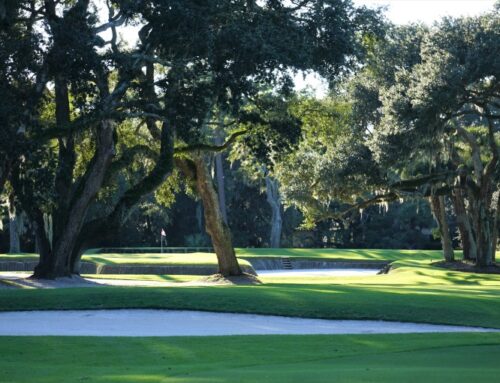Erin Hills Golf Course, WI, USA

With scintillating terrain like this left by glaciers, only the barest minimum of earth needed to be moved.
Given the mechanics of most people’s swings and their twitchy putting, one needs to be a dreamer to play the sport. Surely I will play better tomorrow! No doubt I’ll make the three-footer next time when it really matters. Though the expression ‘field of dreams’ is associated with another sport based on a popular movie, it applies equally well to golf. Just as people who play the sport are dreamers, so too need be people who get involved in bringing golf courses to fruition. One of the most interesting field of dreams projects to occur in America in recent times happened thirty-five miles north and west of downtown Milwaukee in Erin, Wisconsin.
Different dreams came to pass for those involved. There was the original developer (Bob Lang) of the gorgeously convoluted and pristine block of land who saw the land’s potential and wanted to put it to use in hosting big events. There were the dreams of America’s most prominent golf course critic (Ron Whitten) who determined that the time was right to push aside the keyboard and get some dirt under his nails. Also, the highly regarded design firm of Hurdzan & Fry with whom Whitten paired was thrilled with the prospects of working on their most inspired canvas to date. And finally, there were the aspirations of today’s owner of Erin Hills (Andy Ziegler). The long time resident of Wisconsin was keen to give back to his beloved home state and proudly wanted to be involved in showcasing his state to the world.
At the core of these dreams was a very special piece of property, 652-acres in Wisconsin’s Kettle Moraine region that was shaped by receding glaciers 10,000 years ago. The rolling, and at times, tumbling site is full of eskers, kames, kettles and wetlands, all focused in a wonderfully random composition. One architect deemed it to be the best inland piece of property he had seen in America since Sand Hills. Primordial landforms surrounded by nothing but the sounds of nature provide the best, most intense connection to nature. Such land/opportunity rarely comes along. Lang, a non-golfer at the project’s start, knew the stakes were high so he issued a Request for Proposal. Whitten had long been at the center of golf course architecture. He was the co-author in 1981 of the cornerstone book on golf course architecture titled The Golf Course and had served full time as Golf Digest’s architecture editor since 1990, having started work there in 1985. He wasn’t an architect but people approached him anyway for design work. When Whitten turned fifty in 2000, he started thinking that he had waited too long and began looking for a special opportunity in which to become engrossed. Fortuitously, this coincided closely with when Lang issued his RFP. Whitten’s bid was noticed by his long-time friend Mike Hurdzan. Both gentlemen were interested in doing a course with friends and they went to visit Lang and tour the property jointly. Whitten was asked to join the bid effort of Hurdzan & Fry and, together, the project was awarded to them in late 2000.
Initially, they thought the land was so good, with so many natural landforms that they could build a course for a scant $1 million including irrigation. As Whitten says, their own challenge was to build the most natural course in America and prove that ‘Mother Nature is indeed the best architect.’ Whitten, Hurdzan and Fry spent over one year walking through the trees and came up with over a dozen routings that all deserved legitimate consideration. There were pros and cons to each. At one point, today’s tumbling twelfth hole was going to the opener but everyone felt that would bring too much congestion to that section of the property. Nobody wanted to see such fine land used for clubhouse/parking instead of golf. They refocused on keeping the course as pristine as possible so the clubhouse ended up well away from play.
September 11th occurred and, like many people, Bob Lang became less bullish. Construction had yet to commence and indeed none would until late 2004. Lang now needed comfort that this project would be a financial success before pressing ahead. Given his considerable pull within golf circles, Whitten was able to get the U.S. Open Championship director Mike Davis from the USGA. to come out in the summer of 2004. In preparation for his visit, Whitten and Lang mowed all eighteen playing corridors and tied cloth on poles to act as flags. Davis was intrigued though non-committal but thought enough of what he saw to return with David Fay, the then Executive Director of the USGA. Fay was visibly impressed with what he saw in October 2004 and shortly thereafter, the 2008 U.S. Women’s Amateur Public Links Championship was offered and accepted by Erin Hills.
They now had the small task of actually building the course! Excluding holes 1,8, 10 and 14, construction was straightforward: after tree clearing, they basically just sprayed Round-Up three times for the fairway areas, then staked out and installed irrigation and finally seeded with fescue. More earthwork was required on the other four holes and with the five par 3s, Whitten says ‘We sprayed Roundup on the (five) par 3s, too, as we simply excavated green basins, hauled off the soil, filled the holes with greensmix sand and graded back to tie into existing grades.’ No doubt, the three men had been true to their vision of adhering as closely to nature as possible. Helping them as the primary shaper was Canadian Rod Whitman. Few are better at moving dirt and yet making it look like nothing was ever touched. Hence, Whitman’s skills were particularly well suited to this project. Several of the tee complexes were benched into hills (e.g. the first, eighth, and eighteenth) that Whitman successfully created to look like natural pieces of the property. According to Whitten, ‘Rod also did a fantastic job in tying in green contours into existing surrounds with the eleventh and twelfth green complexes being fine examples.’
The course opened for play in late 2006. Expectations were sky high. Yet, the fescue fairways hadn’t been given a proper chance to knit together. The retail golfer grumbled. While there was much to like, there were unusual features too that were a lighting rod for criticism. The fact that the turf wasn’t ready for play only exacerbated the negative sentiment toward the design. The typical American golfer was taken back by several of the more pronounced design features, including a Dell par three, an elevated Biarritz green at the end of long par five and blind shots played from the first and seventeenth fairways. To the author, these sound like intriguing features! Yet, all along, Lang had been angling for a big event including a U.S. Open. Bottomline: these classic design features, as steeped in history as they may be, were a hindrance to a) the popularity of the course from green fee paying customers, b) the pace of play and c) Lang’s chance of getting a U.S. Open.
Over the next few years, these features were eradicated. The project complete, Hurdzan, Fry and Whitten left the site but Lang continued to tinker with it. Lang’s enthusiasm for the project had grown to the point where he wasn’t able to leave well enough alone. The ‘less is more’ doctrine adapted by Hurdzan, Fry and Whitten didn’t resonate. He built bunkers here and there and a handsome – but expensive – clubhouse. Money went out faster than it came in and Lang reached the point where he needed to take on a partner or sell the course. At stake was Erin Hills’ ability to provide suitable infrastructure to host the 2011 U.S. Amateur which they had been granted after the Public Links. At this point in its life, the course had strayed from its original vision of closely adhering to nature. For instance, when it opened the course had sixty bunkers and now it had double that. Some were in goofy spots too, as in blind over the crest of hills. Again, the retail golfer grumbled.
In October 2009, Lang sold Erin Hills to Milwaukee based businessman Andy Ziegler. A low profile, high quality person, his immediate involvement ensured that all goals would be met. This great property was now matched with an owner who would take good care of it. The course had the financial stability of which most clubs can only dream. The short-term work required for the U.S. Amateur occured and the long-term goals of seeing this wonderful property put to great use would be realized. USGA stalwart and past Vice-President Jim Reinhart suggested to Ziegler that Hurdzan & Fry be invited back. The course was closed for seven months as Dana Fry went to work softening features and removing unneeded bunkers. The course re-opened in August 2010. According to those involved, Ziegler looked at purchasing Erin Hills almost as a philanthropic endeavor, hoping to bring the first U.S. Open to Wisconsin and provide a venue that would support and celebrate amateur golf as well in his native sports-crazy state. His desire to remain in the background and to let Erin Hills speak for itself is refreshing in this age of self-promotion. Both Lang and Ziegler’s dream of bringing a great event to Wisconsin was realized when in 2010 the USGA awarded the U.S. Open to Erin Hills for 2017.

From the start, Fry was convinced that fewer trees was the way to go. Before the 2010 season, an additional 300 trees were removed, opening up vistas such as this from the fourth hole to the eighth.
Regardless of the three versions (i.e., the original design as it opened, the one that Lang tinkered with, and the one today), the most important thing is how does today’s course play? That answer is unequivocally very well. There are lots and lots of holes to admire, many are one-off befitting this unique site. The worst holes or weak links are hard to identify. The overall texture and fabric of the course have come together beautifully. Green Keeper Zach Reineking, who has been here since the start, has the fine fescue fairways and bent putting greens both fast and firm. The turf quality is of a uniform high standard throughout – Fry called the playing conditions ‘phenomenal’ after a tour in September 2013 and can’t praise Reineking’s work enough. Trees are gone and the fescue waves proudly in the wind, leaving no doubt that the course has settled on its identity. Erin Hills has joined a small, select group of uniquely American prairie courses where one feels that a large body of water must surely be over the next ridge.
While, with its tall fescues, the first look at Erin Hills from the clubhouse gives golfers the impression that the course must occupy a sandy site similar to that at Sand Hills, the reality is that the property has a hodge-podge of soils termed “glacial till,” the churned up result of the receding glaciers 10,000 years ago. Some parts of the property have the desired sandy soil; some have heavy, dense soil; some even have the dreaded clay and others even had gravel and large boulders remaining. The result is that proper conditioning requires more effort than at uniform sites blessed with sandy soil throughout.
To complicate matters, Hurdzan was adamant on fine fescue for the fairways (as well as the rough) to ensure that the course played fast, to allow the natural topography to be highlighted, and to allow for a variety of recovery shots around the greens (note: the greens are A4 bentgrass). He had seen how well the fescue grassing scheme paid off at their Devil’s Paintbrush design north of Toronto and knew that bent fairways would ultimately require too much water and fertilizer to achieve the objective of molten fairways and bouncy-bounce golf. Hurdzan was wise to push for fescue as only in this manner can the course play as well as it looks. Rye and other grasses are too sticky to let the ground contours have their proper say in how the holes play. To help the fine fescue, Reineking initiated an aggressive top-dressing program after the course changed ownership in 2009.
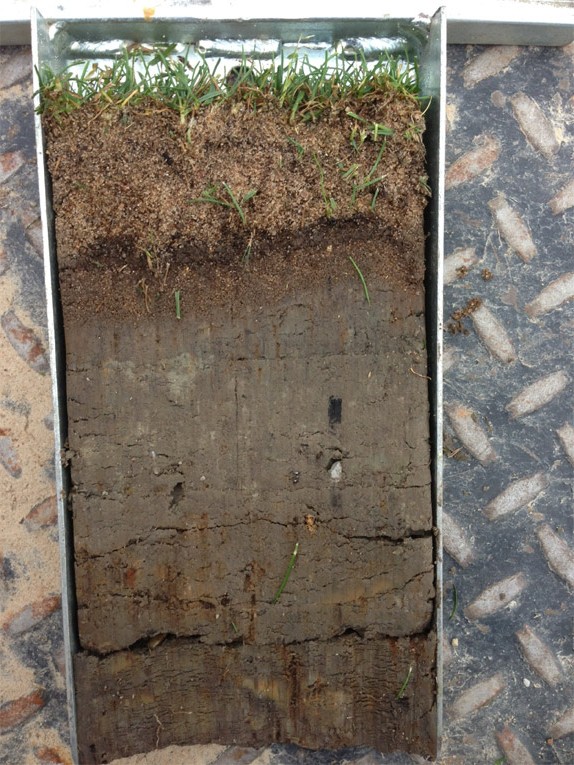
Extensively top dressing a course in Wisconsin is not cheap. Ziegler’s involvement meant that Reineking now had the funds to pursue such an aggressive campaign. The results speak for themselves in the side sample above with the sand top dressing on top of the heavy clay.
The addition of 1200 tons of sand (!) on the fairways each year has benefited both the fine fescue and the overall drainage. While the battle against invasive grasses such as poa annua, bentgrass and ryegrass is never truly over, Erin Hills has achieved a comfort and confidence with the fine fescue that bodes well for a firm and fast 2017 U.S. Open. Think about it – how often can American courses realistically reach and maintain that state in mid-June?
This is not to say that Erin Hills bills itself as a pure fine fescue course. Areas consisting of heavy soils or clay with limited drainage require the use of different species of grass such as rye, which can tolerate these extremes. The goal is certainly to reduce if not completely eliminate the 15 – 20% of fairway turf still consisting of invasive grasses, and the ability to do so will continue to improve with each top-dressing.
The look and feel of Erin Hills and the quality of the turf present an enticing prospect. How about the holes themselves – how well did the architects do? Let’s go for a tour to see if the golfing quality is as appealing as the aesthetics.
Holes to Note
(Please note: Set over an expansive piece of property, Erin Hills can easily stretch over 7,800 (!) yards. The distances cited below are from the green tees of 6,755 yards.)
First hole, 540 yards; Once despised by many golfers with its tree in an awkward location along the edge of the wetland and the lack of visibility of the second-shot landing area, this three-shotter has matured into a well regarded opener. The hole’s best features lie in its final 60 yards, with the fairway flowing into the green that juts out into the wetland. A player hitting a long shot into the green needs to skirt past a final set of bunkers some 50 yards short of the green and watch his ball take the nine degree sloping land and trundle onto the open green. The fact that bunkers so far removed from a putting surface influence play to such a high degree is the first indication that this course represents a brand of golf different to what the golfer may be accustomed.
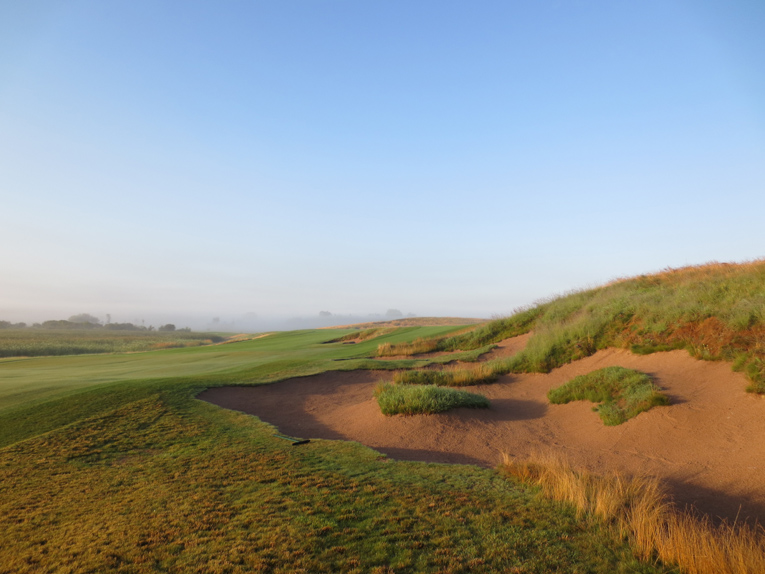
With the wetland to the left and this bunker to the right, the opening tee shot demands the player’s attention. As is also the case with lay-up seconds to the fourteenth and eighteenth holes, the second shot here tests a player’s discipline as he needs to aim well away from the visible green.
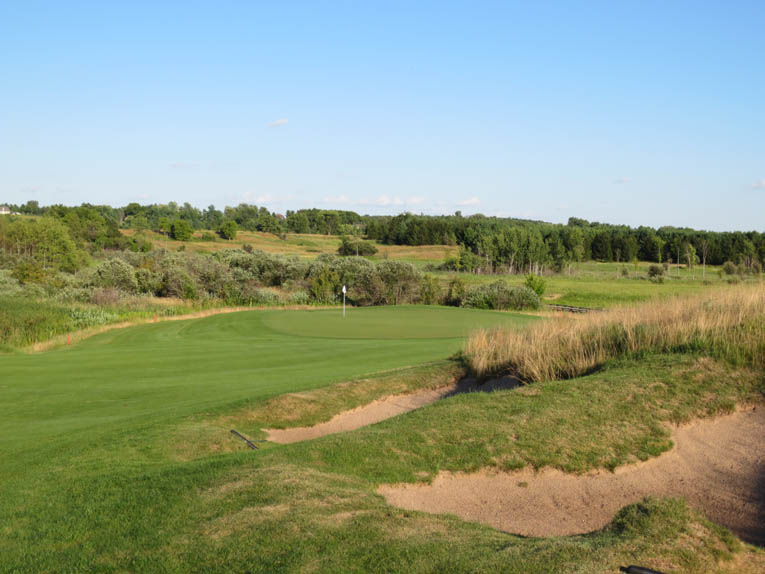
These bunkers protect the high side of the fairway. Shots that squeeze past them will kick left and follow the natural grade onto the putting surface.
Second hole, 320 yards; Perhaps the most fun hole on the course, the second not coincidentally offers the most strategic tee shot on the course. The player who trusts his knowledge that the fairway swings wide left beyond the hill is rewarded with a view of the target for his pitch, while the golfer who cannot conjure up the nerve to hit his ball out of sight beyond the left hill and instead steers his tee shot towards the portion of the fairway that is visible straight ahead will be left with a blind pitch with a pot bunker threatening from the right. The tiger can do better and consider blasting his tee shot over the bunkers towards the hole itself. Some may even play 3-wood off the tee to leave a full pitch to this elusive target. At 2,700 square feet, the green is the smallest on the course, although it is now twice the size of the original as additional hole locations were needed. As Whitten notes, ‘Originally, we just leveled off a knob and voilà, there was the green measuring 1,300 square feet.’ The green resembles the proverbial upturned saucer and runs deceptively away from the player, making even the low marker content with a 15-footer for a 3.
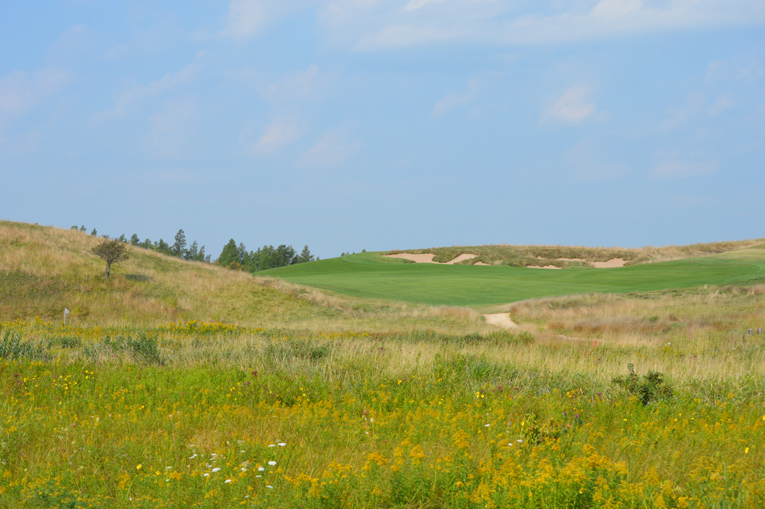
Though it may not look like it, the prudent line off the second tee is over the left hill, well left of the visible bunker.
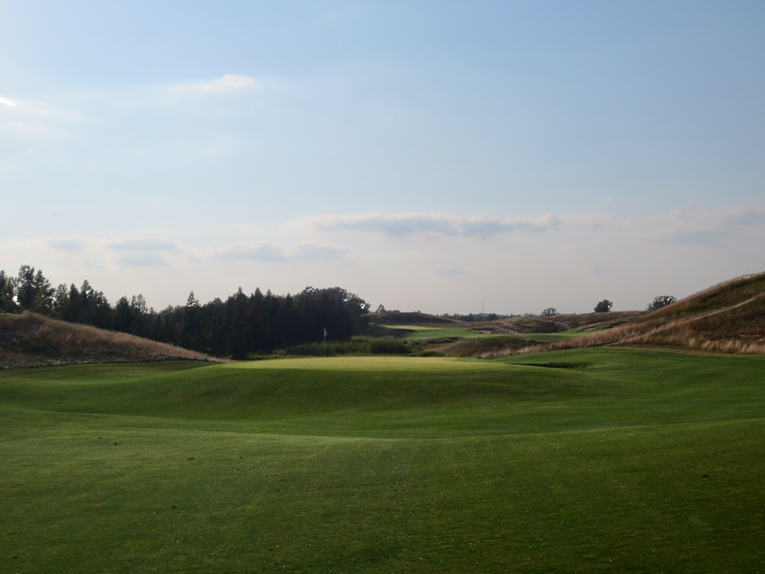
A well-placed tee shot affords a full view of the tiny, domed green. Though the approach shot may be short, this is not the time to be greedy. Play for the middle and putt out to the hole locations. The late day lighting highlights what finicky recovery shots await the golfer who misses the putting surface.
Third hole, 420 yards; During Mike Davis’s initial walk around the property (i.e., before construction), he made a sage observation to both Lang and Whitten. Knowing Lang’s expressed desire to hold big events here, Davis remarked that he appreciated the potential fairway widths of forty to sixty yards but the fairways would need to be narrowed for certain USGA events. Specifically, he made the point that he hated to see bunkers separated from fairways by a ten or fifteen yard band of rough. Such bunkers were essentially meaningless. Davis stressed the need to make sure that bunkers protrude well into fairways and the architects heeded that advice through construction.
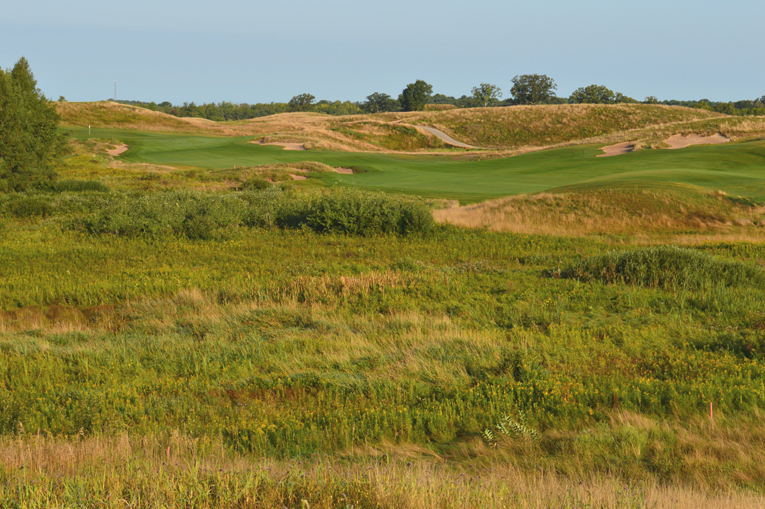
Both landforms for the lower left and upper right tees existed. The angles of play are excellent from the lower left one as seen above and …
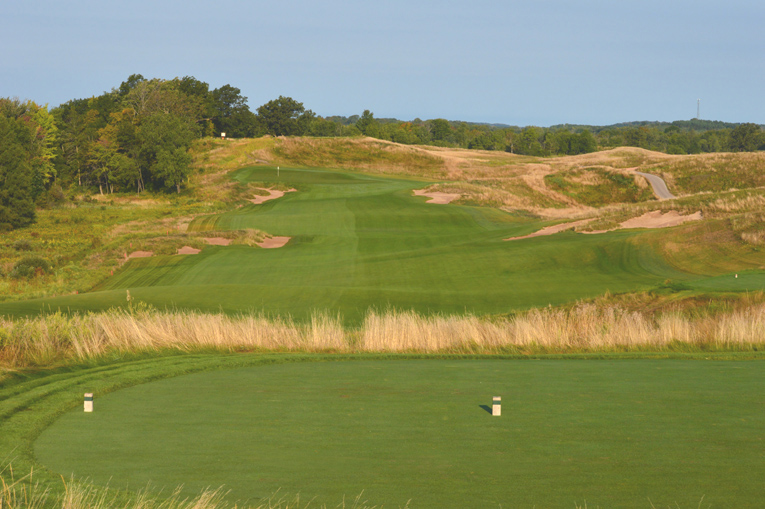
… there is no denying the thrill of playing from the upper right one as well. Note how the left fairway bunker complex protrudes into the fairway and therefore always influences play.
Fourth hole, 385 yards; Surprising for a hole of this length, the fourth consistently plays as one of the five hardest holes during events. The fairway is one of the narrowest and is even more vexing to find as many golfers make the mistake of believing that there is more fairway to the left out of view. The approach demands precision, with a mean front bunker in the center, false front on the right and a drop-off to a wetland beyond the green. The challenge is further enhanced by the interior contours of the green that are more severe than first seems. Fry in particular likes the variety of hole locations. A false front and false back highlight how short grass is used as a real menace on approach shots played to right hole locations while left ones must contend with bunkers. Aesthetically, one of Fry’s favorite moments on the course occurs walking from the tee to the fairway on this downhill hole as a glorious long view slowly unfolds.
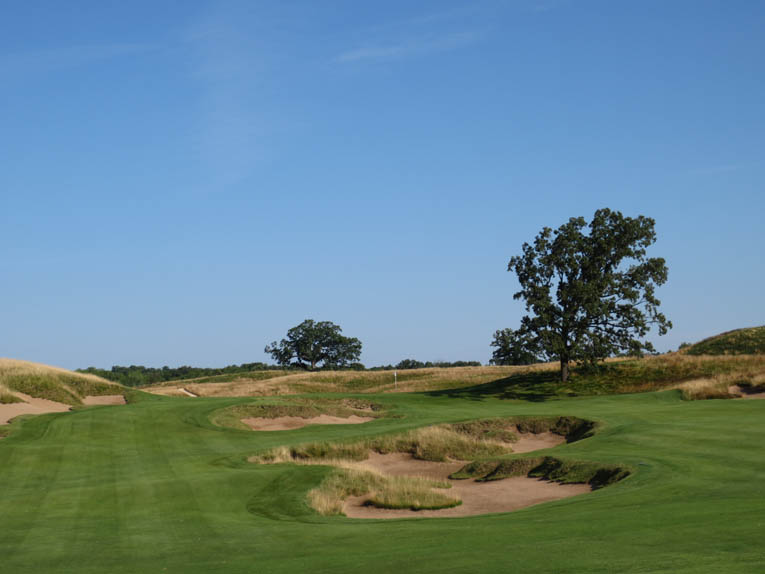
The central bunker forces the longest hitters to think twice about playing driver off the tee and forces those who miss the fairway to make a decision as well.
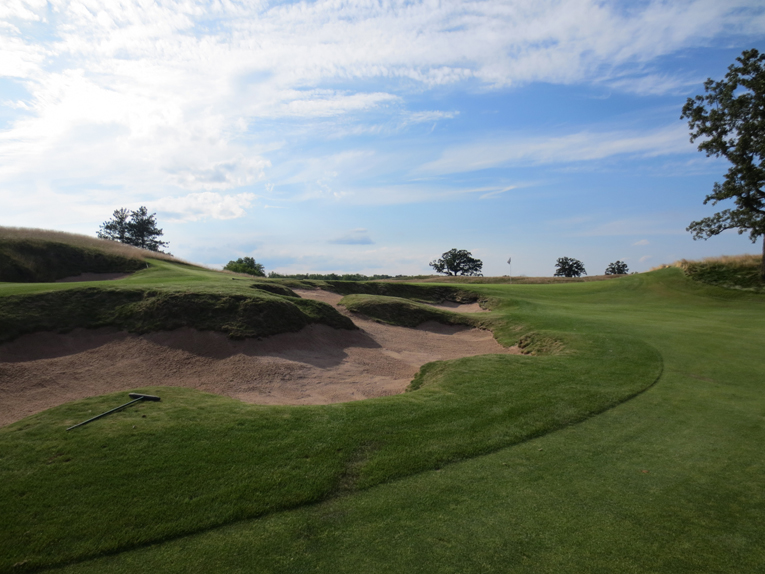
The serpentine bunker fronting the fourth green follows the natural contours while providing some tough front left hole locations. Note the false front right. To repeat: the day’s hole location can markedly change the task at hand on one’s approach to the fourth.
Fifth hole, 405 yards; Not every hole should scream for the golfer’s attention. Otherwise, the golfer’s senses eventually become dulled. The fifth in many ways captures the essence of the place with the architects disturbing the rolling land to the bare minimum. Just how different the holes can play was on prime display during the U.S. Amateur. From the back markers, golfers who hit into the upslope off the tee would be left with approach shots in the 200 yard range. Fry saw one golfer in particular though whose tee ball flew the hill and received a huge kick forward, leaving him but 80 yards from the green on a day when the hole measured near 500 yards! Holes at traditional parkland course never play so wildly different. Watching the range of how these holes play over a four day event will be ceaselessly entertaining. Though subdued in appearance compared to the approaches into the twelfth or fifteenth greens for instance, the one at the fifth is highly rewarding. Options abound, including bouncing a ball in to the left of the greenside bunker and seeing it feed right across the putting surface. While the fifth may feel like a connector hole because of the long walk to its tee and the parallel seventh fairway, its golf qualities are decidedly first rate.
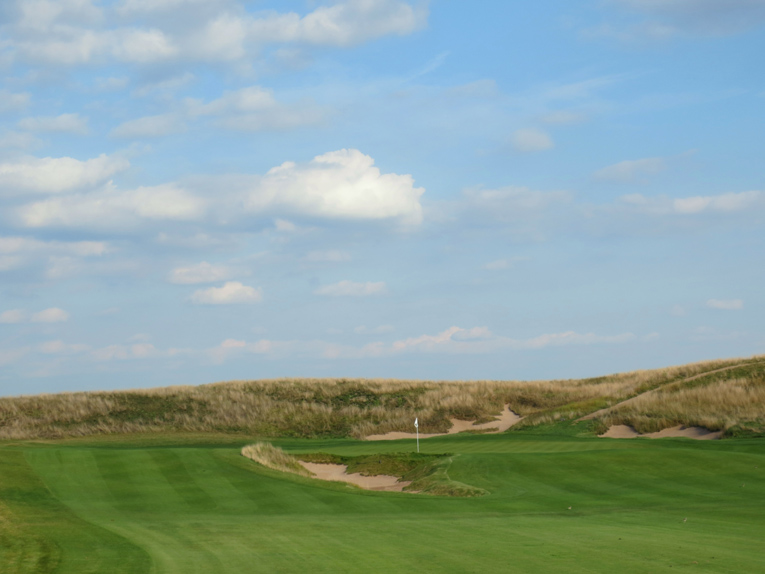
Give Mike Davis credit for ensuring that the grass was keep short and tight well left of the bunker during the U.S. Amateur.
Sixth hole, 190 yards; Somewhat reminiscent of the thirteenth green at Machrihainsh with its challenging combination of a false front followed by a front-to-back pitch, the sixth green provides an ample target but a tough one to find a reasonable birdie putt. Parenthetically, the following hole was a par 3 Dell hole from 2006-2009. Though not ideal, the fact that back to back par 3’s existed highlighted the architects’ desire to find the best holes as provided by nature, regardless of how they fell on the scorecard.
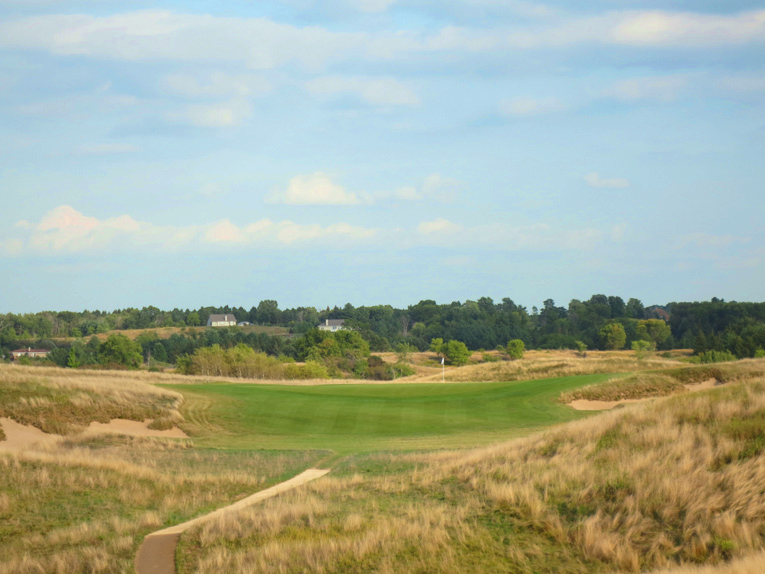
A view of the sixth from the high back markers. As with most holes at Erin Hills, there is plenty of room to operate but it takes a skilled shot to get a ball within twenty feet of the hole.
Eighth hole, 410 yards; With its right-to-left sweep around a hill, the eighth is one of the course’s few true dog-legs. Depending on the tees and the direction and strength of the wind, the golfer has to decide how much of the left hill he should attempt to bite off. The landing area is appropriately wide for a hole of this length and type, while the approach is almost shockingly demanding, with a mid-iron across a valley to an elevated green guarded by bunkers in front. Whitten credits Tom Doak with helping to shape his thinking on such holes. As Whitten explains, ‘Apart from the putter, every club in the bag is intended to help get the ball airborne. Landing shots twenty yards short of a green and having it run on is fun but so too is using internal contours on or beside the green to work balls to certain hole locations. We focused on getting all the ripples in and around the elevated eighth green just right so that the thinking golfer can use slopes to his playing advantage.’
Ninth hole, 145 yards; The shortest hole at Erin Hills is far from the easiest. In fact, this downhill, exposed one-shotter was the sixth most difficult hole during the stroke-play portion of the 2011 U.S. Amateur. The left bunkers are some of the meanest on the course and often leave a player hoping to card a bogey. Given how it meets all infrastructure requirements, Erin Hills is primed to host countless televised events going forward. The ninth may not be that well known today but with time, the author will be shocked if this doesn’t become recognized as one of the great/notorious one shotters in American golf, right up there with its prairie cousins like the second at Prairie Dunes and the seventeenth at Sand Hills.
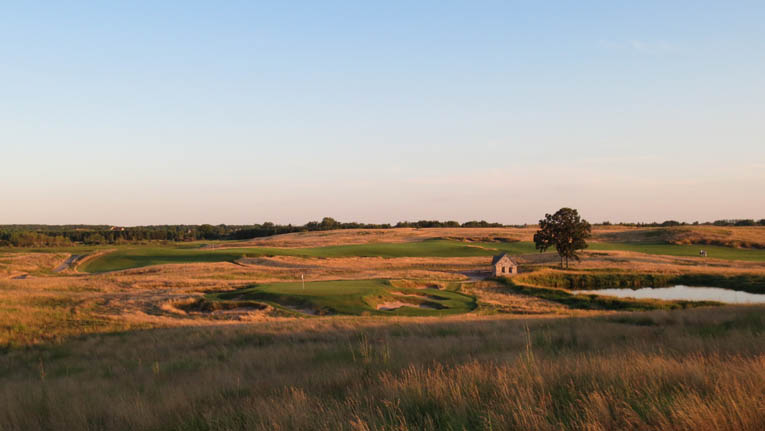
Unlike the eighth, the pushed up ninth green is a hit it or else proposition. When the wind kicks up, this little hole becomes daunting.
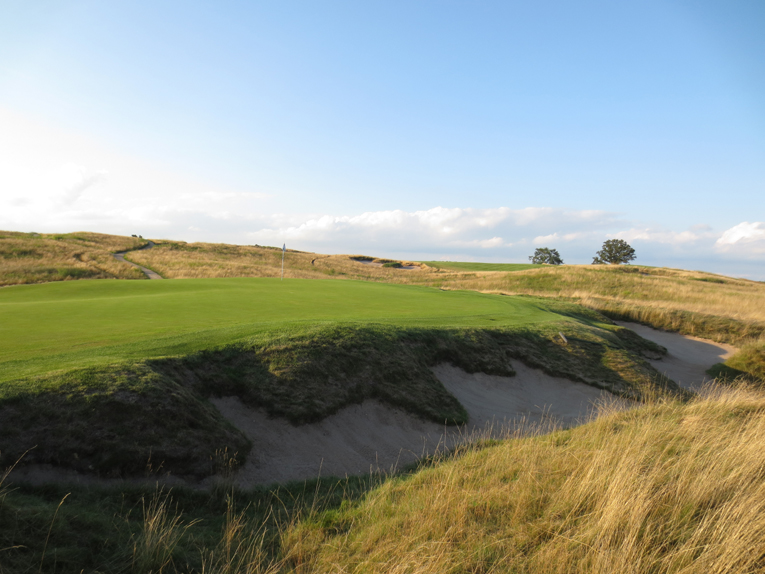
The bunker behind the ninth green is not visible from the tee and has led to several ugly surprises for players who thought they had hit good tee shots. Note the bunker’s superbly wicked narrow left finger which is barely big enough for ‘an angry man and his niblick.’ This photograph also captures a key element of the short hole’s defense which is that the shoulders of the green slope away on both sides toward gathering bunkers.
Tenth hole, 450 yards; Lang shrewdly purchased two different blocks of property to create the expansive chunk that is Erin Hills today. What a pity it would have been if the architecture was cramped in any manner. Happily, it isn’t with this hole being a prime example of the broad-shouldered nature of the place. From a design point, the tenth green complex also shows how a course can work for all level of golfers. The tiger will enjoy attempting to carry the largest greenside bunker on the course while the less accomplished player is given plenty of room left of the green from where he can tack in on his third for an up and in par.
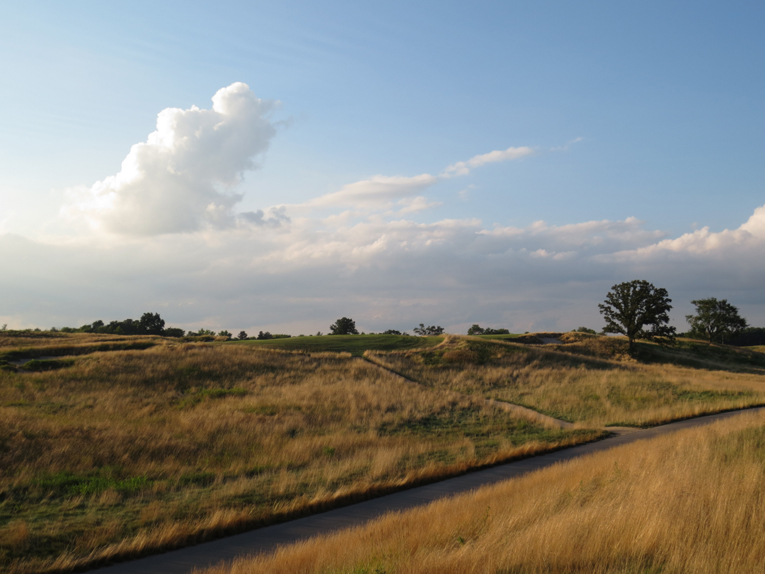
One of the author’s favorite tee shots is this uphill blind one at the tenth. A course over such rambunctious land should feature at least one such tee ball.
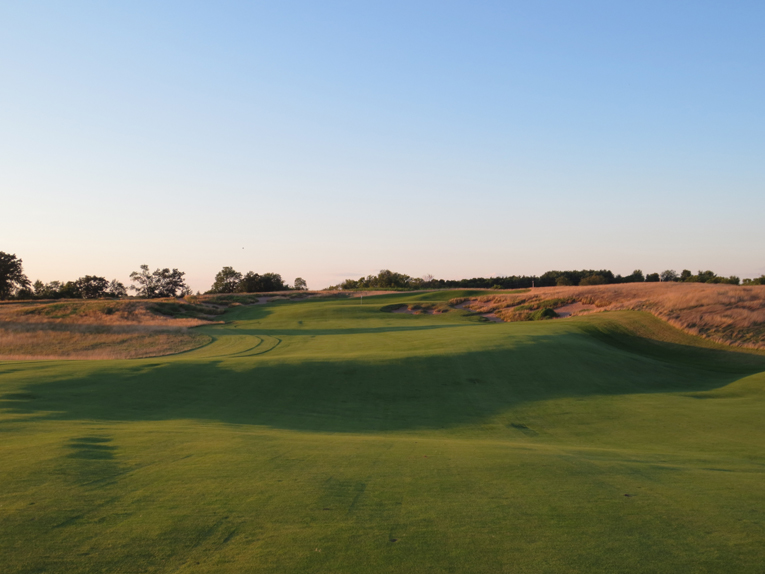
The beautiful landforms were brilliantly employed within the confines of the 65 yard wide fairway. Strategy abounds, as tee shots down the right find the downslope, giving players an additional ~30 yards of roll.
Eleventh hole, 315 yards; Great land is irrelevant if its contours aren’t brought directly into play. At the eleventh, a hillside was captured by the architects in the fairway and serves as a sideboard for tee balls played down the right of the fairway. Technically, this is the narrowest fairway on the course but it doesn’t play that way thanks to this sideboard. The fairway’s strong right to left slopes are contrast intriguingly with the dominant left to right slope found around and within the green. After the demanding prior three holes, the eleventh provides a welcome change of pace that signals the varied/interesting holes that lie ahead.
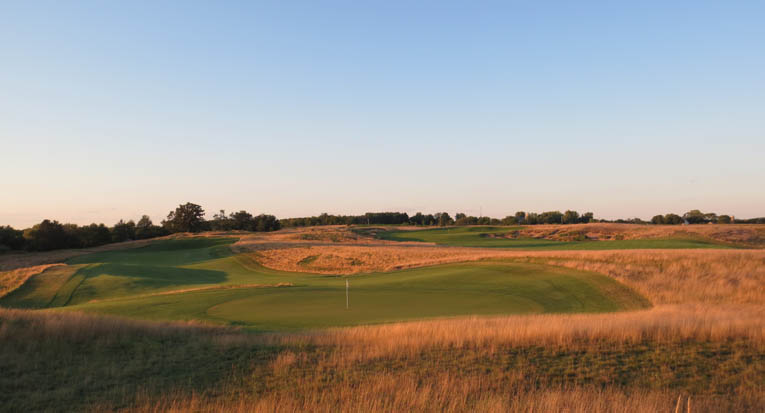
As seen from behind the eleventh green, the diverse natural slopes that dictate play are evident. A lot of trees were removed, but little earth was moved in creating this hole.
Twelfth hole; 390 yards; The twelfth hole uses the best topography of the course to full effect. Whitten says, ‘What marvelous landforms to use for golf. You would never build a hole like it but since it is there, we would have been crazy not to take advantage of it.’ Unless the hole is into the wind, the player can try to knock his tee shot down the far hill, leaving himself a short-iron to the green (which is hidden if he drives left but visible if he braves the right side). If he lays back to the top of the hill, he faces an invigorating approach down the hill – one of the few downhill approaches on the course. The green is deceptive, with its ridge across the center that leaves the back half of the green running away from the player. This is a prime example of what people mean when they write about a well routed hole over great land. Courses over more mundane land can’t compete with drama so deeply rooted in nature.
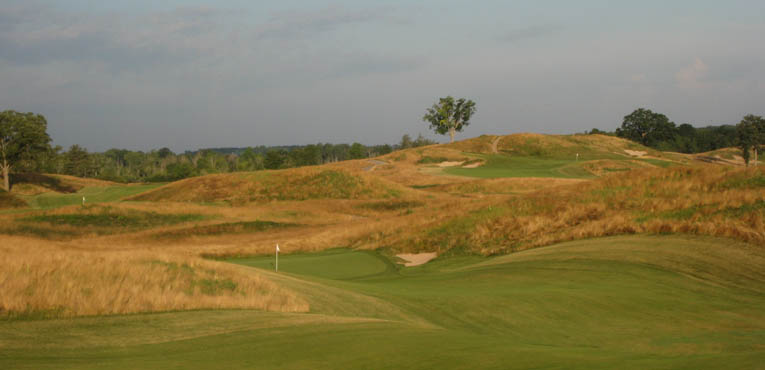
If the drive is over the hill, the approach from the left is blind, encouraging players to hug the right side.
Thirteenth hole, 170 yards; A sleeper of a hole, the thirteenth offers more than first meets the eye. With the sprawling bunker built into the left hillside, many golfers err to the right, leaving a recovery shot that encourages indecision from the closely mown area. Should I putt, chip or pitch the ball? With a shallow swale that runs across most of the center of the green and a front that does not allow balls to bounce onto the green, front hole locations are challenging to approach, especially downwind. This hole can provide tremendous variety to those who play the course on multiple days, as one day the hole may call for an 8-iron to a front hole and the next day a 4-iron to a back hole location.
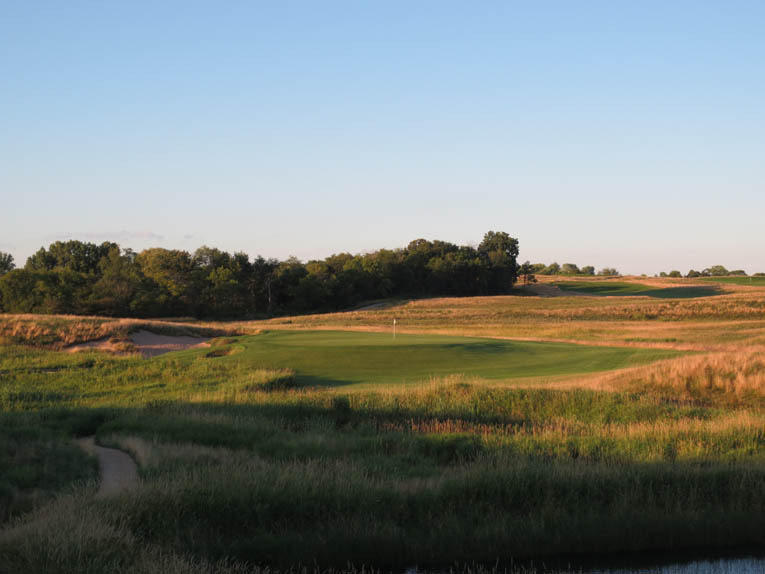
Sand left and grass right: Which way to err? Also, note the clean lines and how nothing distracts the eye from the surrounding beauty.

Bunkers come in all shapes and sizes at Erin Hills. On the thirteenth this small pit is paired with a sprawling erosion bunker.
Fourteenth hole, 505 yards; This serpentine hole plays straight as a gambling two-shot hole, with the tee shot over the two bunkers on the left side and the second across an expansive native area to a green that steps down from left to right and features an extreme false front. As a three-shotter (whether into the wind or from a back tee), the second shot is far from a throwaway, as the farther up the fairway it is played, the more of the green is visible. The player is then left with an intriguing pitch as, because of the angle, the two levels run away from the player. As uncluttered as this hole appears, Whitten is quick to note that nature isn’t (always) perfect and that sometimes you have to help her along in such matters as drainage. Take here for instance. Whitten notes, ‘Rod Whitman was important in reshaping the fourteenth fairway, which had been a bean field. He extended from the existing esker on the left a low ridge diagonally across the fairway and subtly shaped it to both drain yet keep balls from bounding right into the wet rough next to the river. Rod’s handiwork looks so natural that no one could ever tell it was once a dead flat bean field and yet it was instrumental to ensure that the fourteenth fairway would drain properly for decades to come.’
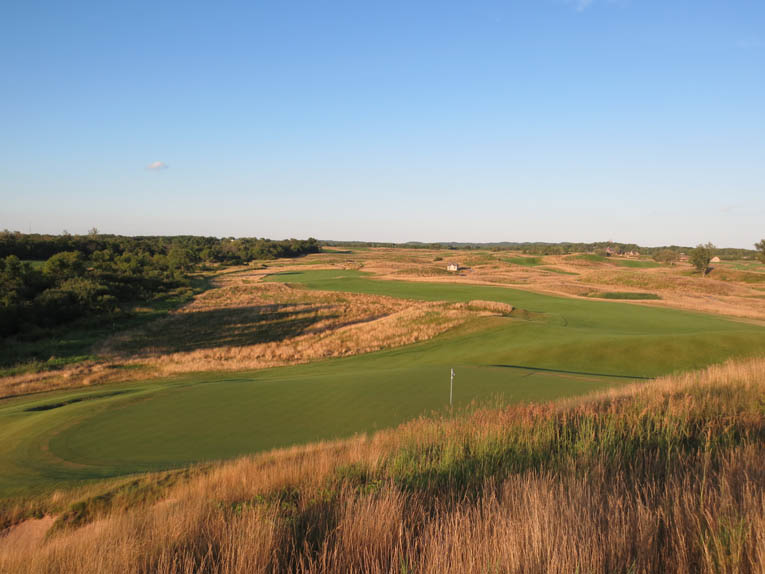
As seen from the fifteenth tee, the question posed by the second shot to the fourteenth is clear: go for the elevated green or lay up well to the golfer’s left.
Fifteenth hole, 345 yards; The tee shot is more straightforward than it first appears, with a number of bunkers inside the fairway. The play is just to stay short of the first bunker and then pitch up to a green that offers three quite different hole locations – in a bowl on the left, dangerously close to the front edge and along the right side and the sharp drop-off (and truly frightening bunkers) on that side. A spine (which has been softened) splits the left and right sides of the green, making a player unlikely to make 4 if his approach is not within 30 feet of the hole.

The volcano green complex didn’t jump out to the architects until many walks around the property as it was shrouded underneath trees.
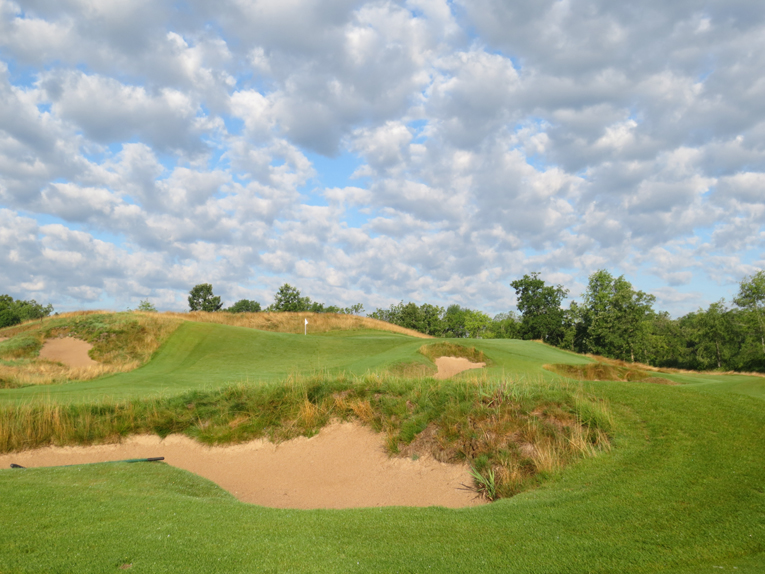
When he was one up, Patrick Cantlay hit 8-iron into this bunker from the forward tee on the 33rd hole of the final of the 2011 U.S. Amateur, made 5, and lost the hole (as well as the sixteenth and the match).
Sixteenth hole, 165 yards; This two tiered green was perfectly tucked into a fold between a tall dune left and a smaller dune right. Looks are deceiving as the hillside on the left is not the golfer’s friend. Balls hit into it will find one of several bunkers at its base that are hidden from view from the tee. Also, not all of the putting surface is visible from the tee either and the uncertainty that creates is an admirable design feature.

Despite the unfortunate placement of the foot path, the sixteenth is one of the most handsome holes on the course.
Eighteenth hole, 620 yards; The fact that the course begins and ends with par fives is noteworthy. What world class course can you think of that does the same? No cheating saying Baltustol Lower either! More important though is the quality of the two holes, with this one fitting the classic definition of a three shotter. Each shot gets progressively demanding with it all played out against the backdrop of Erin Hills’ Lodge and the basilica of Holy Hill in the distance. While the shape of the hole is a mirror image of the fourteenth, except with a freakish wind or a freakish golfer, the eighteenth always plays as a three-shotter, and a stout one at that. With his second the golfer must be disciplined enough to aim well to the right from the visible flagstick. The third is the most precise iron the player is asked to play all day, thanks to the cluster of bunkers on the left, false front on the right and dramatically severe closely mown fall-off back-left.
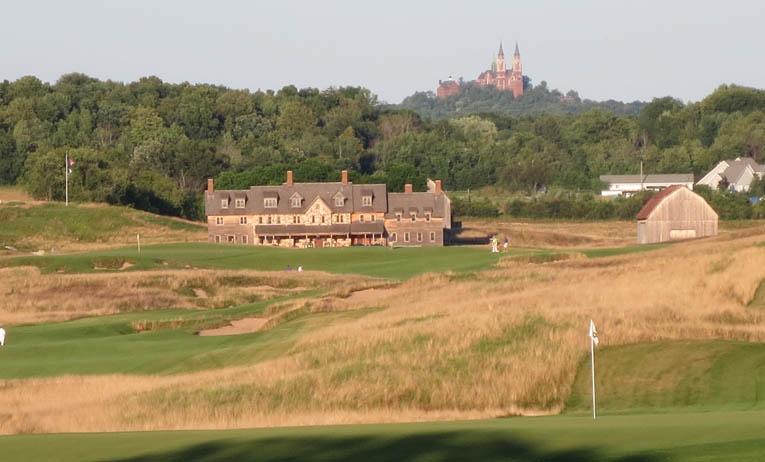
As seen looking across the seventh green, there are many prospective aiming points while playing the eighteenth from the spires of the distant basilica at Holy Hill to the chimneys of the Lodge.
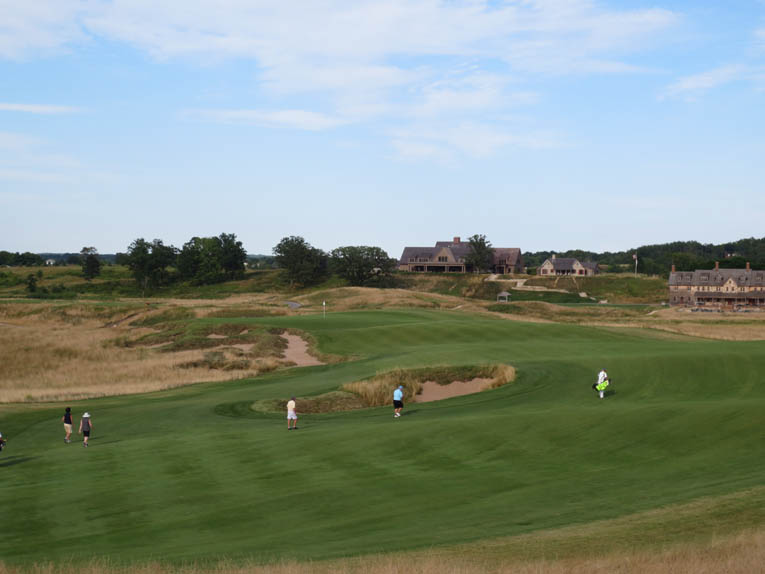
With the second shot on the long eighteenth, players need to decide whether to lay up short of this bunker (120 yards from the green), go left, right or blast over it. The brain needs to stay sharp to the very end at Erin Hills. A pitch with too much spin just short of today’s hole location can come back off the green’s false front and roll well away.
There you have it – a tour of a singular course over uncommon land.
The blessing – and curse – of great land is that it gives the architect scores of permutations in how to layout a golf course. The abundance of natural features create a plethora of design options that don’t exist on more commonplace sites. As such, the opportunity for both success and failure are elevated. If the architect is worth his salt, great holes ensue. So too can holes that he wants to try because the opportunity is so unique. Erin Hills went through a trial and error process in the first ten years of its life. An example of an admirable hole that was built but that ultimately didn’t work was the Dell hole, the seventh hole on the original course. The envelope of land practically begged for such a time-honored hole. Yet, in the grand scheme of hosting major events, such an antiquated hole didn’t fit the course’s bigger purpose. Does that mean that the construction of the hole was folly? Not necessarily. A chance was taken to do something different, something that was entirely in keeping with the land. It didn’t work for the long haul purposes of the course and that’s O.K. The key thing is to recognize the fact and take corrective action. That’s what happened at Erin Hills.
Erin Hills will be over ten years old when it hosts the U.S. Open. It enjoys ~200 acres for village tents, parking, media, and handles with ease the other space requirements for staging a big event. Its climate makes it ideal for hosting events during the dreaded months of June through August where so much of the country suffers through high humidity and high evening temperatures. Copious natural high vantage points make it a dream spectator course as well. The high right side of the first and eighteenth alone could hold 50,000 spectators, all with great views! Seeing tee balls run out sixty or eighty yards is refreshing in America. Given the stamp of approval placed on Erin Hills by organizations taking their prized events there, this type of bouncy-bounce golf will hopefully gain a foothold in America and act as a beacon for the way forward.
From its quixotic beginnings to now, much has transpired. There is every reason to believe the best has yet to come. Only time can confer upon Erin Hills the status that it should obtain given the superlative property upon which it was built. It is of the ilk of Pebble Beach, Pinehurst No.2, The Ocean Course at Kiawah, and Bethpage Black in that the average golfer has access to it, can have a blast playing it, and is likely to fall under its spell. In addition, every five to ten years, he can delight in watching it on television and compare his results to the tiger golfer who might well be playing a course ~1000 yards (!) longer.
Thanks to all the hard work both above and below ground since its inception, the author believes that Erin Hills is now charted on the proper path to become deeply embedded in the American golf culture.

A field of dreams indeed! Looking across the eighteenth fairway to the ninth green with the tenth fairway stretching away in the distance.
The End


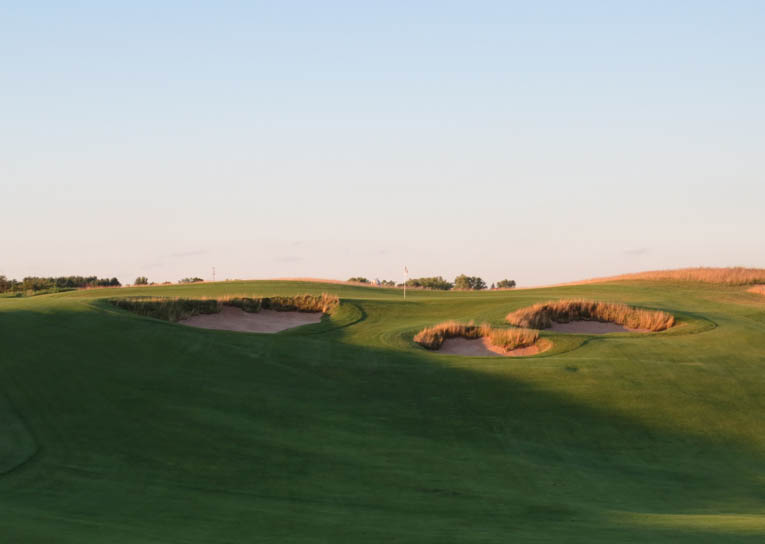
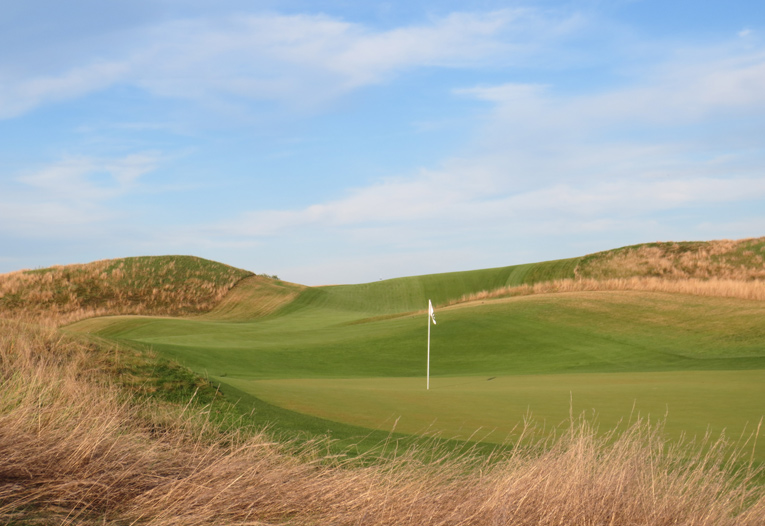


![The Park, West Palm (Lit 9) [2023]](https://golfclubatlas.com/wp-content/uploads/2024/12/IMG_7092-2-scaled-500x383.jpg)



